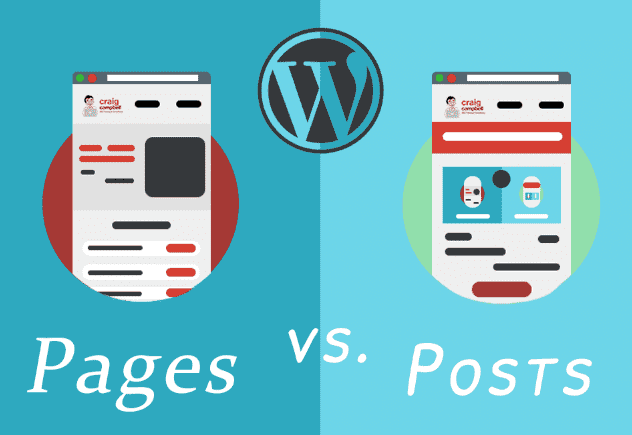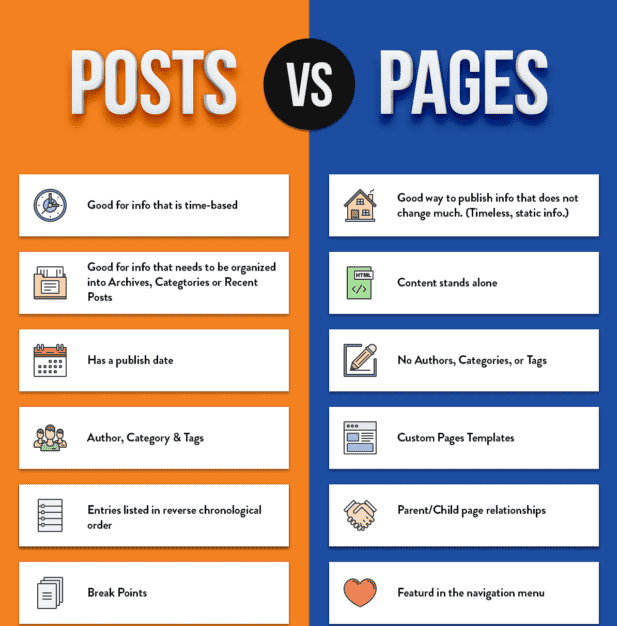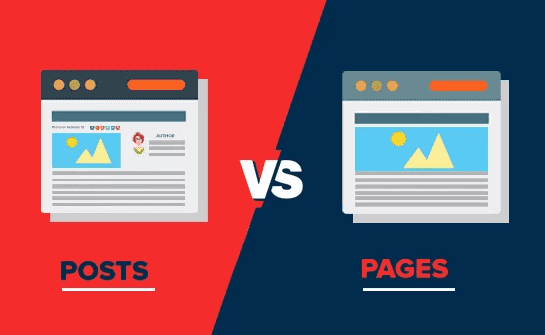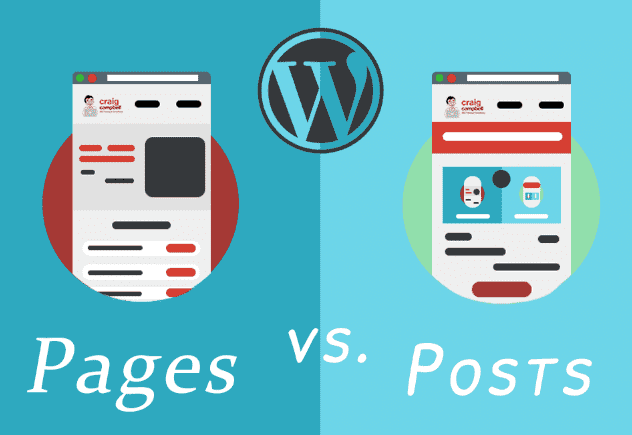wp post vs page: What is the Difference?
When growing a new website using WordPress, the first question is whether or not to pick out the put-up page. Page while creating the brand new Whenever every type of post and page is used to add content to your website, they serve distinctive reasons and have interaction otherwise. In this article, we will destroy the differences, explain how to use each effectively and help you decide whether to use a submit instead of a page.
What is a WORD PRESS Post?
Definition and Features
WordPress posts are content entries listed in opposite chronological order in your weblog. They are typically used for:
• Blog entries
• News articles
• Updates
Key Characteristics of Posts
Chronological Order:
Posts are displayed by date, with the latest posts at the top.
Categories and Tags:
Posts can be prepared using classes and tags, making it less complicated for readers to discover associated content.
RSS Feeds:
Posts are included in RSS feeds, meaning they may be automatically introduced to readers who subscribe to your feed.
Comments:
Posts generally allow feedback, permitting interplay with readers.
Social Sharing:
Posts are frequently shared to draw readers and grow engagement.
Creating a Post in WordPress
Login to Your Dashboard:
Navigate to your WordPress dashboard.
Add New Post:
Click “Posts” inside the sidebar, then “Add New.”
Write Your Content:
Add an identity, write your content material, and format it using the editor.
Categories and Tags:
Assign relevant categories and tags.
Publish:
Once satisfied, click “Publish” to make your put-up stay.

What is a WordPress Page?
Definition and Features
WordPress pages are static and commonly used for, more often than not, equal content. Joint makes use of pages encompass:
• About Us
• Contact Information
• Privacy Policy
• Services Offered
Key Characteristics of Pages
Static Content:
Pages aren’t listed through date and do not alternate often.
Hierarchy:
Pages can be nested underneath different pages to create a hierarchy (e.g., a “Parent Page” and “Child Page”).
No Categories or Tags:
Unlike posts, pages do not use classes or tags.
No Comments:
Pages do not permit comments by default; however, this can be modified.
No RSS Feeds:
Pages are not included in RSS feeds.
Creating a Page in WordPress
Login to Your Dashboard:
Navigate to your WordPress dashboard.
Add New Page:
Click “Pages” within the sidebar, then “Add New.”
Write Your Content:
Add a name and write your content material.
Parent Page:
If needed, assign a parent page to create a hierarchy.
Publish:
Once glad, click “Publish” to make your web page stay.
Detailed Comparison of WordPress post vs pages
| Feature | WordPress post | WordPress pages |
| Data-based Listing | Yes | No |
| Categories and Tags | Yes | No |
| RSS Feeds | Includes | Not included |
| Comments | Enabled by Default | Disabled by default |
| Social sharing | Often shared on social media | Less frequently shared |
| Static comments | No (Frequently Updates | Yes |
| Hierarchical | No | Yes |
| Typical Uses | Blog posts, News articles | About us, Contact services |
When to Use Posts
Posts are best for content material that you’ll update frequently. Consider the usage of posts for:
Regular Blog Updates:
Sharing ongoing stories, thoughts, or news.
Time-sensitive Content:
Such as announcements or event recaps.
Engagement:
When you need to interact with readers through remarks and discussions.
When to Use Pages
Pages are exceptional for static, undying content. Use pages for:
Static Information:
Information that doesn’t change frequently, like “About Us” or “Contact” pages.
Important Policies:
Legal or privacy rules that continue to be steady.
Core Information:
Details approximately services or products provided through your business.
Differentiating Between WordPress Posts and Pages
Understanding the exciting features and using WordPress posts and pages is crucial for effectively coping with content on your WordPress website. Here, we will delve into the exact changes between posts and pages to help you decide on a good use for each.

Content Nature and Purpose
WordPress Posts
Dynamic Content:
Posts are designed to change frequently updated information. They are best for weblog entries, information updates, and announcements.
Time-touchy:
Posts are time-touchy and often well planned chronologically, first highlighting the maximum current content material.
WordPress Pages
Static Content:
Pages are used for static content without much trade. Examples include “About Us,” “Contact,” and “Privacy Policy” pages.
Timeless:
Pages are timeless and meant for statistics that stay applicable over time.
Setting up and organising
WordPress Posts
Chronological Order:
Posts are indexed by date, with the latest posts performing first. This layout suits content that builds over time, like blog entries.
Categories and Tags:
Posts may be organized using classes and tags. Categories group posts from institutions into broad topics, while tags allow for extra-specific term connections, which makes it easier to search and navigate.
RSS Feeds:
Posts are included in RSS feeds, meaning subscribers can get digital information as soon as new content is posted.
WordPress Pages
Non-chronological:
Pages aren’t searched by date and don’t show up in chronological order. They are static and are now not part of a standard feed for this blog.
Hierarchy:
Pages can have a hierarchical shape, in which you may assign a parent page to create a nested employer. This is beneficial for organizing content into sections (e.g., a “Parent Page” with “Child Pages”).
No Categories or Tags:
Pages do now not use classes or tags; they’re standalone pieces of content and not a part of a chronological blog feed.
Interaction and Engagement
WordPress Posts
Comments:
Generally, posts provide feedback, allowing readers to interact with the content, author, and others. This encourages the building of networks and dialogue.
Social Sharing:
Posts are often held on social media systems to grow visibility and force site visitors to the website.
WordPress Pages
Comments:
Pages do not allow reviews using default, even though this can be changed inside the settings. Comments on pages are less unusual because the content is usually static and informational.
Less Social Sharing:
Pages are less often shared on social media because they might not be used for real-time reports anymore but for showing important, static data.
SEO and Traffic
WordPress Posts
SEO Benefits:
Because of their frequent updates and dynamic nature, posts can entice more visitors and social shares, positively impacting search engine scores. Search engines favour sparkling content material, which could improve posts’ search engine marketing performance.
Keywords and Metadata:
Posts can be optimized with keywords, metadata, and different search engine optimization strategies to improve visibility and entice natural traffic.
WordPress Pages
SEO Stability:
Pages, even static, can be optimized for search engine marketing. They are vital for offering foundational statistics and can be optimized for applicable key phrases.
Long-term SEO:
Pages contribute to long-term search engine optimization by offering steady and dependable data that can rank well over the years.
Usage Scenarios
WordPress Posts
Blog Entries:
Regular updates, private mind, enterprise information, and ongoing memories.
Announcements:
Time-touchy content material, including event recaps, announcements, and seasonal topics.
Tutorials and Guides:
Step-by using-step instructions, how-to publications, and educational content.
WordPress Pages
About Us:
Information about the internet site or corporation, providing history and context.
Contact Information:
Details on the way to attain the website online proprietor or corporation, which include touch bureaucracy, email addresses, and bodily addresses.
Legal and Privacy Policies:
Important prison facts, privacy rules, and terms of provide.
Service Descriptions:
Detailed descriptions of the services or products provided by using a business.
SEO implications of content type selection
Selecting the perfect content type—post or web page—can substantially affect your website’s search engine optimization. Both content types have specific characteristics influencing how search engines index and rank your website. Understanding those differences can help you optimize your content strategy for better search engine performance.
SEO Implications of WordPress Posts
Dynamic Content and Freshness
Frequent Updates:
Posts are always changing and updated, which search engines like Google like because it means the content is fresh and relevant. Frequent updates can cause more common indexing with the aid of seek engine bots.
Current Trends and Timely Topics:
Posts often cover cutting-edge activities, trends, and timely topics that may attract immediate hobby and social shares. This engagement can improve your site’s relevance and authority in engines like Google.
Keywords and Metadata
Keyword Optimization:
Posts with specific keywords applicable to contemporary subjects and trends may be optimized. This centered approach can help entice organic traffic attempting to find those particular phrases.
Metadata:
Posts may be better with metadata, along with meta descriptions, alt tags, and identify tags, which are essential for SEO. Properly optimized metadata can improve click-through quotes from search engine consequences pages (SERPs).
Categories and Tags
Organizational Structure:
Organizing posts using categories and tags allows search engines like Google and Yahoo to recognize the structure and context of your content. Well-organized posts can also improve the website’s online navigation and consumer enjoyment, which might be an essential SEO element.
Internal Linking:
Tags and classes facilitate internal linking, distributing link equity across your website and improving the crawl ability of your content.
Social Sharing and Backlinks
Social Media Engagement:
Posts are regularly shared on social media systems, producing one-way links and riding site visitors to your web page. Social signals can, in a roundabout way, impact SEO by growing your content’s visibility and credibility.
Backlinks:
Quality posts that provide valuable facts are likelier to be linked to by other websites. Backlinks are a critical ranking element for engines like Google.
Engagement Metrics
Comments and Interaction:
Posts typically allow feedback, fostering interaction and engagement. High engagement rates can signal to search engines that your content is treasured and relevant, doubtlessly boosting your ratings.
SEO Implications of WordPress Pages
Stability and Long-term Relevance
Evergreen Content:
Pages are best for evergreen content that remains relevant over time. This stability can contribute to constant search engine optimization overall performance, as engines like Google value reliable and undying facts.
Authoritative Content:
Pages regularly include foundational information, such as “About Us,” “Contact,” and “Services.” These pages help establish your web page’s authority and credibility, which is essential for SEO.
Keywords and Metadata
Strategic Keyword Placement:
Pages must be optimized with strategic keywords that replicate your website’s center topics. These key phrases help search engines understand your website’s primary focus online.
Comprehensive Metadata:
Like posts, pages ought to contain optimized metadata to improve search engine visibility. This consists of meta descriptions, header tags, and photograph alt tags.

Site Navigation and User Experience
Hierarchical Structure:
Pages can be organized hierarchically, creating a clean structure that improves website navigation. A nicely structured web page complements a person’s reveal, making it more straightforward for search engines like Google and Yahoo to move slowly and index your content.
Main Navigation:
Pages regularly form part of the main navigation menu, making essential statistics effortlessly handy. Good navigation can reduce soar quotes and boom time spent on your site, both high-quality search engine marketing indicators.
Backlinks and Internal Linking
Internal Linking:
Pages are regularly linked from your website’s primary navigation menu and different essential sections, distributing link equity effectively.
Backlink Potential:
High-quality, authoritative pages are likelier to earn one-way links from other websites. For example, an appropriately crafted “About Us” page or a complete services page can entice hyperlinks from industry directories and partner websites.
User Engagement
Reduced Interaction:
Pages usually do not enable comments, resulting in decreased interaction compared to posts. While this might restrict personal engagement, it makes a specialty of handing over clean, authoritative information.
Comparison: SEO and implications of posts vs. pages
| SEO Factors | WordPress post | WordPress pages |
| Content Freshness | Dynamic, Frequently updated content | Static evergreen content |
| Keyword optimization | Targeted, Trend-specific Keywords | Core, strategic Keywords |
| Metadata | Optimized with meta description, tags, and titles | Optimized with comprehensive metadata |
| Organizational structure | Categories and tags for easy navigation | Hierarchical structure for clear navigation |
| Internal linking | Enhanced by tags and categories | Linked through main navigation and site hierarchy |
| Backlinks | More likely to attract backlinks due to fresh content | Likely to attract backlinks due to authoritative content |
| Social sharing | Frequently shared, increasing visibility | Less frequently shared focus on essential info |
| User Engagement | High engagement through comments and interactions | Lower engagement, focus on delivering information |
| Site Navigation | Organized through categories and tags | Integral part of main navigation |
Strategic Use of Posts and Pages for Search Engine Marketing
Leveraging Posts for search engine optimization
Regular Updates:
Update your blog with new posts to preserve content freshness and promote standard numbering in search engines like Google.
Engaging Content:
Create engaging, shareable content that attracts one-way links and social stocks.
Optimize for Trends:
Use posts to cover trending topics and keywords, shooting well-timed search hobbies.
Leveraging Pages for SEO
Authoritative Content:
Develop comprehensive, authoritative pages that establish your site’s credibility and give out essential records.
Optimize Structure:
Make sure your pages are well-prepared in a layout with levels, making travel and user experience more accessible.
Consistent Keywords:
Use regular, strategic keywords across your pages to improve your page’s main themes and make it better for search engines.
Conclusion
WordPress posts and pages have great uses and characteristics critical for powerful content management and SEO. Posts that change and respond to time entries are appropriate for blogs, news updates, and interactive information, put together in order and optimized for engagement through feedback and social sharing. Pages are static and permanent, perfect for essential records that don’t change the “About Us” and “Contact” sections, providing a stable building and authoritative content.
When deciding between posts and pages, think about the nature and cause of your content. Use posts to stay regularly up-to-date material that benefits from frequent engagement, trend optimization, and pages for foundational, evergreen content that enhances website shape and authority. When used strategically, both content material types contribute to a balanced and effective search engine optimization strategy, improving your website page’s visibility and performance in seek engine effects.
